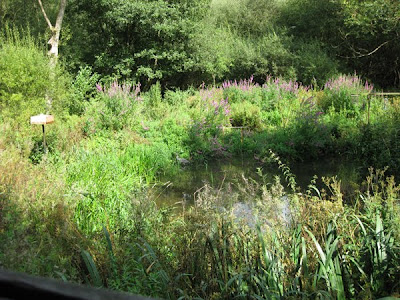Yesterday I had one of my best urban butterfly sightings. This Painted Lady feeding on a Buddleia in a car park across the road from Leeds Magistrates Court at the Westgate end of the Headrow. Unperturbed by traffic heading out of Leeds City Centre just metres away, the Painted Lady alternated between feeding on this Buddleia and basking open winged on the pavement below. Ive seen other butterflies in this area before including Large White & Speckled Wood, but this is the first opportunity Ive had to get a decent pic. I like this side profile in particular because its curly proboscis and antennae are clearly visible whilst there's slight movement in its wings.
Ive seen other butterflies in this area before including Large White & Speckled Wood, but this is the first opportunity Ive had to get a decent pic. I like this side profile in particular because its curly proboscis and antennae are clearly visible whilst there's slight movement in its wings.
We visited Adel Dam for the first time on Saturday, what a lovely woodland reserve & surprisingly peaceful on a busy sunny day when neighbouring Goldenacre Park was full of visitors. You can find a handy map at Yorkshire Wildlife Trust .  Marsh Hide Feeding Station overlooks a small pond brimming with lush vegetation & surrounded by a variety of mature mixed woodland. The close proximity to the pond provides a fine view of the inhabitants. The plentiful feeders attracted a steady procession of small woodland birds Coal Tit, Great Tit, Marsh Tit, Robin and a Nuthatch appeared intermittently. A couple of Magpies arrived prompting expectation that they'd hog the feeder but didn't stay long presumably full from an earlier feed.
Marsh Hide Feeding Station overlooks a small pond brimming with lush vegetation & surrounded by a variety of mature mixed woodland. The close proximity to the pond provides a fine view of the inhabitants. The plentiful feeders attracted a steady procession of small woodland birds Coal Tit, Great Tit, Marsh Tit, Robin and a Nuthatch appeared intermittently. A couple of Magpies arrived prompting expectation that they'd hog the feeder but didn't stay long presumably full from an earlier feed.  A Grey Heron appeared & settled imposingly on the diminutive pond. It skulked round the margins of the pool successfully hunting small fish. We watched as a dragonfly darted foolishly over the Heron. It coolly kept its beady eyes on the insect, suddenly extending its long neck & darting its beak skywards to pluck the dragonfly out of the air & with a crunch made a tidy snack of it.Gotcha...
A Grey Heron appeared & settled imposingly on the diminutive pond. It skulked round the margins of the pool successfully hunting small fish. We watched as a dragonfly darted foolishly over the Heron. It coolly kept its beady eyes on the insect, suddenly extending its long neck & darting its beak skywards to pluck the dragonfly out of the air & with a crunch made a tidy snack of it.Gotcha... A Treecreeper spiralled up a Willow trunk probing for insects.
A Treecreeper spiralled up a Willow trunk probing for insects.
 The Nuthatch didn't stay for long before it was off again, this was the best I could manage.
The Nuthatch didn't stay for long before it was off again, this was the best I could manage. The second hide overlooks Adel Dam, a much larger body of water. The water level is low at the moment & the birds were scarce, mainly Coots, Mallards, Moorhen. Here's the view.
The second hide overlooks Adel Dam, a much larger body of water. The water level is low at the moment & the birds were scarce, mainly Coots, Mallards, Moorhen. Here's the view.  A Red Kite soared overhead.
A Red Kite soared overhead. At the water's edge a fox crept through the thicket contemplating duck for tea no doubt. It mooched around for a minute dissappearing into the trees.
At the water's edge a fox crept through the thicket contemplating duck for tea no doubt. It mooched around for a minute dissappearing into the trees.  Ten minutes later we spotted a flash of colour to our right & a fox darted out of the undergrowth & trotted away from us through the waterside vegetation.
Ten minutes later we spotted a flash of colour to our right & a fox darted out of the undergrowth & trotted away from us through the waterside vegetation.  It appeared a few minutes later at the opposite bank quickly slipping out of view into the trees. Then we became aware of its reflection in the water as it settled near a flock of waterside birds waiting unnoticed for an unsuspecting bird to stray nearby.
It appeared a few minutes later at the opposite bank quickly slipping out of view into the trees. Then we became aware of its reflection in the water as it settled near a flock of waterside birds waiting unnoticed for an unsuspecting bird to stray nearby. 

 Ive seen other butterflies in this area before including Large White & Speckled Wood, but this is the first opportunity Ive had to get a decent pic. I like this side profile in particular because its curly proboscis and antennae are clearly visible whilst there's slight movement in its wings.
Ive seen other butterflies in this area before including Large White & Speckled Wood, but this is the first opportunity Ive had to get a decent pic. I like this side profile in particular because its curly proboscis and antennae are clearly visible whilst there's slight movement in its wings.
 And just in case there's any question of unsubstancial evidence to support the sighting, here's Leeds Magistrate's Court in the background.
And just in case there's any question of unsubstancial evidence to support the sighting, here's Leeds Magistrate's Court in the background. 















































